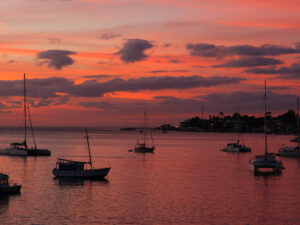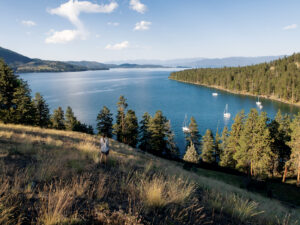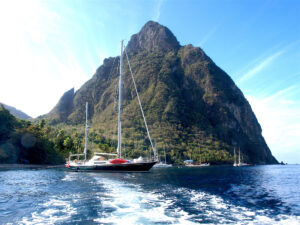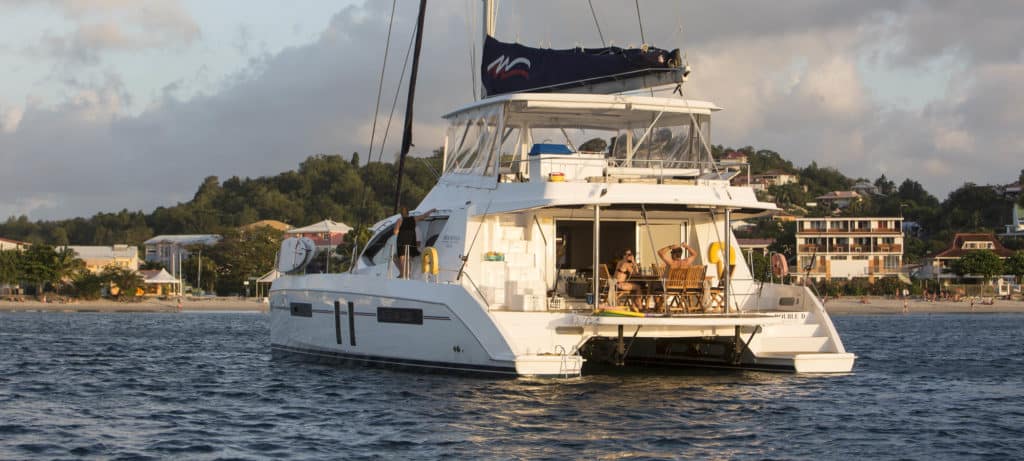
One of the things that makes the Windward Islands such a fantastic place to sail is the wind — it’s always blowing, or at least it has been the three times I’ve visited. Friends and I have bashed our way northward between islands, sailing hard on the breeze in big open-ocean swells, and we’ve surfed down waves with the speedo pegged in the teens while reaching south. Even in the lee of the islands, where the water’s flat and the breeze might go dead-calm, the crew has been kept on its toes by gusts that can come barreling down the valleys from the mist-shrouded peaks at any moment.
Those glorious trade winds came on with a vengeance one day last winter as five pals and I sailed south along the coast of Martinique aboard a Moorings 5800 catamaran, bound for St. Lucia. With the anemometer hovering in the mid-30s, it was a day better suited for a snug harbor and snorkeling, but we were set to fly home to the frozen north the next morning, so like it or not, our boat, Double D, had to be returned to its base in Rodney Bay.
Had I been the one on the wheel, my knuckles would have been white, for sure. Instead, as the puffs came on and the apparent wind pushed 50 knots, my fingers clutched an ice-cold brew and I sat back to enjoy the ride, confident that Capt. Cosmas Elibox — “Cosy,” as he liked to be called — had it all under control. Welcome to the pleasures of a crewed charter.
This little adventure came together at the suggestion of The Moorings general manager Josie Tucci. Why not, she said, join her in St. Lucia aboard the six-cabin 5800 for a sail up to Martinique to check out the rum-distillery tours the company was about to launch?
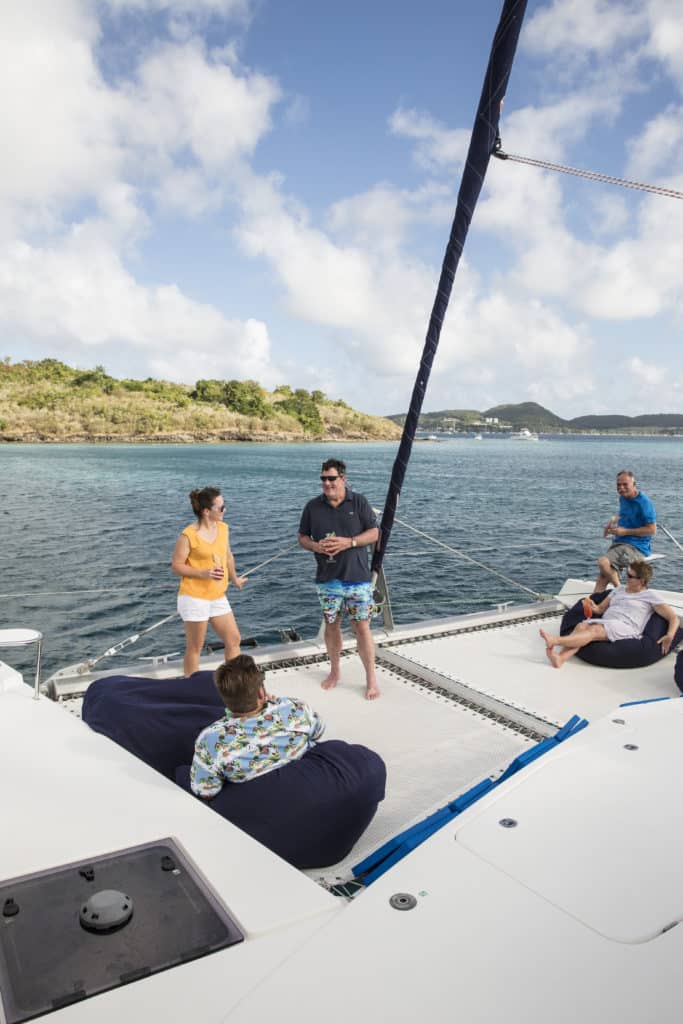
Why not, indeed? We brought along photographer Marianne Lee to chronicle our investigative-reporting efforts, so that still left two more cabins for guests. Josie invited along Nick Crabtree, a racer who works with Pindar International and handles logistics for the Volvo Ocean Race and other grand-scale regattas. I tapped hometown friends and sailors Tom and Kathy Famulari, who’d recently been smitten by the Caribbean during a bareboat charter of their own.
Besides finding flights to get us to St. Lucia on a Saturday afternoon, the biggest concern before the trip began was where we’d be able to watch the Super Bowl the day after we arrived in the Caribbean. Tom, Kathy and I are from New England, after all, and the Patriots were shooting for another victory and Tom Brady’s fifth championship ring. Missing the game wasn’t an option.
We needn’t have worried; Cosy had us covered. But we’ll get to that in a minute.
At the start of our adventure, we arrived dockside too late for our planned Saturday departure, so we made the most of our first evening in the Caribbean by getting our charter briefing out of the way and settling in aboard Double D. Our orientation involved rounds of rum punches, followed by a fine dinner of steaks, veggies and spuds, washed down by a delicious malbec. Chef Dekoda “Vicky” Dowers immediately impressed us with her culinary skills, learned on her home island of nearby St. Vincent and honed by years of practice in the charter trade.
First thing Sunday morning, Cosy collected our passports and headed off to customs to take care of paperwork. Josie took the opportunity to stretch her legs on a little run accompanied by first mate Brad Gangardine, a strapping and handsome lad who kept the ladies highly entertained and answered our every food and drink request with a gleaming smile. I walked a similar route toward Pigeon Island National Landmark, a hilly park on St. Lucia’s northwest coast. Sunday is play day for St. Lucians, and traffic was brisk with cars and pickup trucks full of beach-bound families. Along the roadside, horses searched for morsels in the scrub brush, and roosters, seemingly everywhere, crowed incessantly as the sun, heat and humidity soared in unison.
Back at Double D, by the time breakfast was done, Cosy had returned and we were off. Outside the marina, we paused briefly to raise the mainsail — I should say the crew raised the main; we sat back and watched — then we rounded Pigeon Point and sailed hard on the wind toward Martinique, barely visible on the horizon, 20 miles to the north.
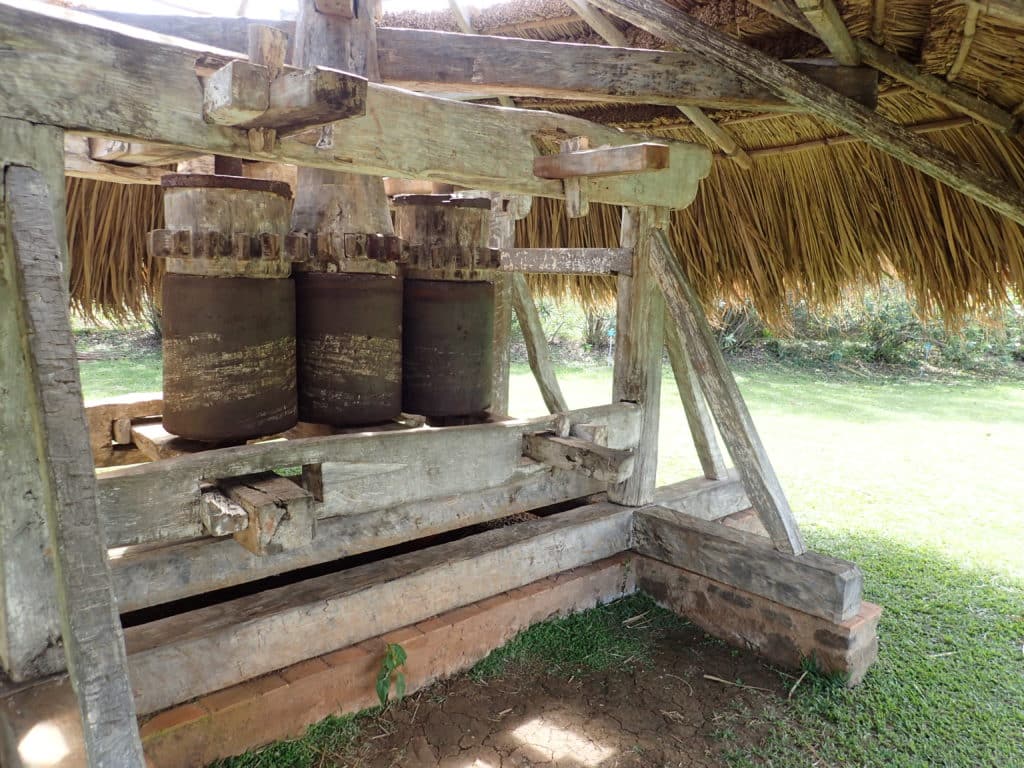
Underway aboard the 5800, the flybridge was the place to be. The 360-degree view was magnificent, and between the helm station and winches forward, and the fridge, grill and drink coolers aft, there were comfortable couches in the shade of the bimini and lounge chairs in the sun. As the miles ticked off, Cosy and Brad, both St. Lucians, answered our many questions about island life and our itinerary over the next few days. The breeze was close to perfect, and we made good progress with a single reef in the main and the genoa rolled out. Slowly, tall, angular peaks in the center and on the north shore of Martinique came into focus, as did the broad valleys to the south, where bananas, sugar and other crops are grown.
Our destination for the day was Ste. Anne, a lovely village on the south coast, and Le Marin, the harbor next door. Cosy never considered firing up the engines to get us in faster. Instead, we approached by sail, tacking right up until we reached the harbor, where we were met by Club Med kite- and windsurfers out enjoying the brisk trades and flat water.
Once anchored, our attention turned to game-day preparations: tasty hors d’oeuvres, and rum bombs to wash them down. Then, with evening approaching, Cosy ferried us ashore. As luck would have it, right in front of us we found Mango Bay, a friendly, open-air restaurant with a television tuned to a French sports channel showing guys tossing a football around the studio.
Kickoff was imminent, so we grabbed an open table right under the screen and discovered we were surrounded by several other spirited Yanks from the anchorage. Most were New Englanders, and like us, they must have been tempted to keel-haul the lone loud and strutting Falcons fan. He took delight in taunting us repeatedly throughout the first half as Atlanta put point after point on the board, and then sat stunned and thoroughly humiliated when his team choked it up big time in the second. Go Pats!
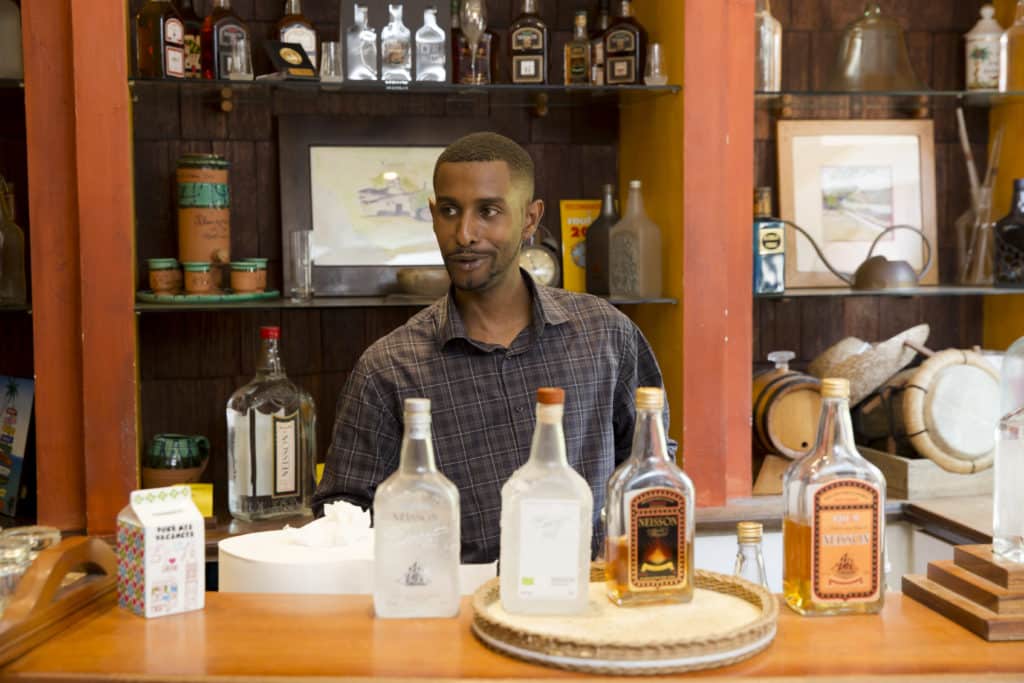
Let the Tours Begin
Monday, the islanders went back to work, and so did we. Breakfast was served early, then the six of us were shuttled ashore to briefly explore Le Marin’s waterfront while waiting for a van to take us to our first distillery, Habitation Clément, a spectacular sugar plantation in Le François, on the island’s east coast. The buildings and surrounding grounds have been restored as an interpretation center of Creole culture.
To get there, we snaked through groves of banana trees, their fruit covered in sacks to keep away the insects, and across broad, green valleys dotted with the occasional village. Up we climbed over the island’s mountainous spine, pausing at the top for a view of the inlets below that are protected from the boisterous Atlantic by offshore reefs.
At Habitation Clément, we rented headsets that provided an English-language self-guided tour of the plantation and we set off down the path from the visitors center. At each stop along the way, we paused and listened: The sprawling fig tree was once thought to house evil spirits; towering royal palms were a refuge for migrating birds; a story accompanied each of the many sculptures created by local artists. We visited the plantation’s working sugar-cane fields, then climbed the hill to see the vats and rugged machinery used in the distillery process. At one building, we stuck our heads into the dark interior, where hundreds of casks of aging rum were stored. In the tropical heat, up to 10 percent of their contents will evaporate through the wooden barrels in a year. After only a few breaths, we made note of having a good buzz going as we stepped back into the sunshine.
Atop the hill sat the plantation house and its outbuildings. A plaque pointed to the rooms where U.S. President George Bush and French President Francois Mitterrand met in 1991 at the end of the Gulf War to discuss the future of Kuwait. Inside the main house, fine antiques filled each room. A refreshing breeze blew through the open windows, and wooden shutters kept the rooms shaded and cool in the hot tropical sun. Afterward, sitting in a finely crafted gazebo and enjoying the breeze that funneled up the valleys from the sea,
I couldn’t help but think that while this would have been a spectacular home for the plantation’s founder, Charles Clément, it was a very different existence for workers who harvested and milled the sugar.
The Clément distillery closed its doors at this location in 1988, when operations were moved to a new facility a short distance away. Restoration of Habitation Clément began in 2005 and is ongoing.
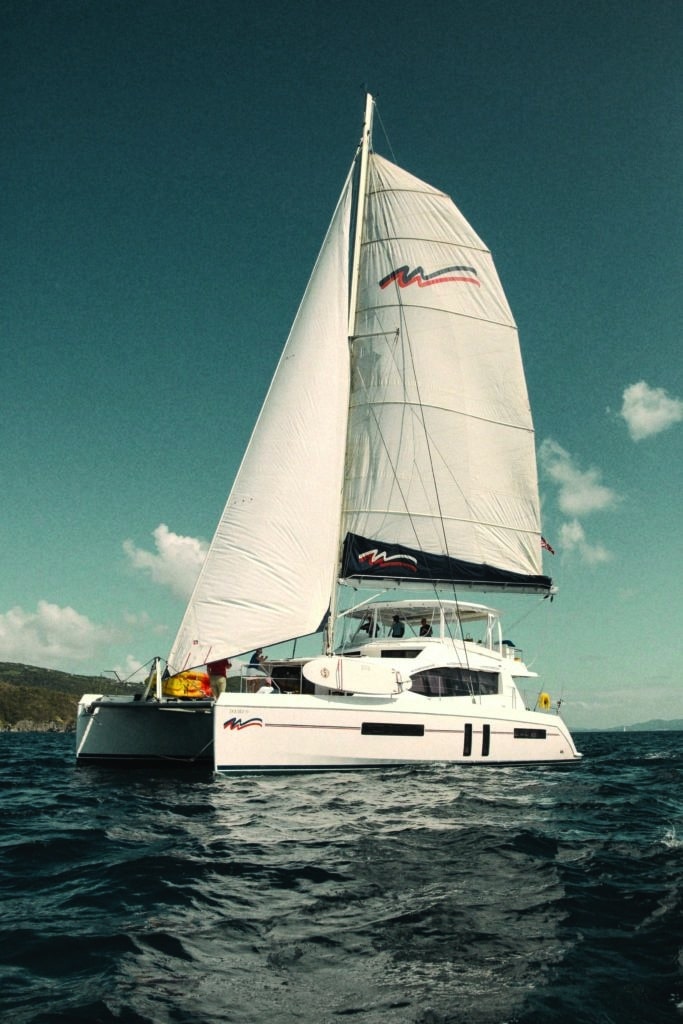
Modern Martinique
After a trip to the tasting room, we left Habitation Clément, toting bags filled with bottles of their finest, and boarded our van for Fort-de-France, a bustling port city on the west coast and Martinique’s capital. The winding mountain road soon turned into a modern four-lane highway flanked by office buildings, houses and shopping centers. Our driver took us to the downtown marketplace, a sprawling indoor collection of stalls, where vendors hawked fruits, vegetables, tangy Caribbean spices and colorful calico shirts and dresses.
For lunch, we climbed to the second floor of the market and chose Mamma’s Shack, one of several restaurants where the maitre d’s jostled aggressively for customers. The menu was strictly local. I ordered goat, cassava beans and rice, and we all shared a helping of cod cakes doused with hot sauce.
Afterward, we did a drive-by of Fort Louis and the waterfront. We looked across broad Fort-de-France Bay to the anchorage where we’d spend the night. By boat, it might have been a quick trip, but a good chunk of the afternoon was spent on the highway as we skirted the shore. Our journey ended in Trois-Îlets, a lively little tourist town of beaches and shops, where Cosy and Brad were waiting for us with the tender.
Double D was anchored just around the corner, at Anse Mitan. It was tempting to swim to shore to investigate the beachfront resort, but instead, we all jumped in and paddled about the boat. Cosy fired up the massive speaker he kept stashed below the saloon table, and so with reggae tunes blaring, we floated on foam tubes and enjoyed a cold beer or two.
Monday night was a beauty. We sat up on the flybridge, enjoying the night sky and the view of lights on the hills overlooking the city.
So far, this had been a fine vacation, but Marianne and I were on the clock, so to speak; I had a story to write, and she needed photos. So, bright and early Tuesday morning, the crew hauled anchor and motored a short way to Anse Dufour, a perfect little horseshoe-shaped cove with a white-sand beach at its center and three colorful little cottages just behind it. The hills rose steeply up from the beach, and gusty winds poured down them. There were fishing skiffs hauled up on the sand, and a handful of folks swam near shore.
When the sun was right, Cosy used a spare halyard to haul Marianne and her cameras up the mast to the first spreaders. Kathy and Tom enjoyed the morning on the foredeck, while I paddleboarded around the cove and Nick and Josie went exploring by kayak. Before long, day boats carrying snorkelers from the nearby resorts arrived and the anchorage became downright crowded. Between swimmers and katabatic gusts, paddling became a lot like work, so we traded board and kayak for masks and snorkels and joined the crowds in the water.
Tuesday afternoon we again set sail, this time heading farther north up the coast to St. Pierre, the northern Martinique town that was wiped out when volcanic Mount Pelee blew its top in 1902, killing nearly 30,000 people and leaving just two survivors. Thirty-plus knots of wind sent us scurrying along on a comfortable reach at 9 knots and better.
When we arrived, Pelee’s summit was covered by clouds, as it almost always is. The hillsides were rich and green-looking, thanks to all the rain that falls there. Ashore, we wandered the streets of the once-again bustling town, where evidence of the deadly eruption can still be seen on the blackened walls of many of the buildings.
Cruising boats — including many a steel vessel flying a French flag — filled the harbor. We swam off Double D‘s stern and savored the sunset on this, our last night out.
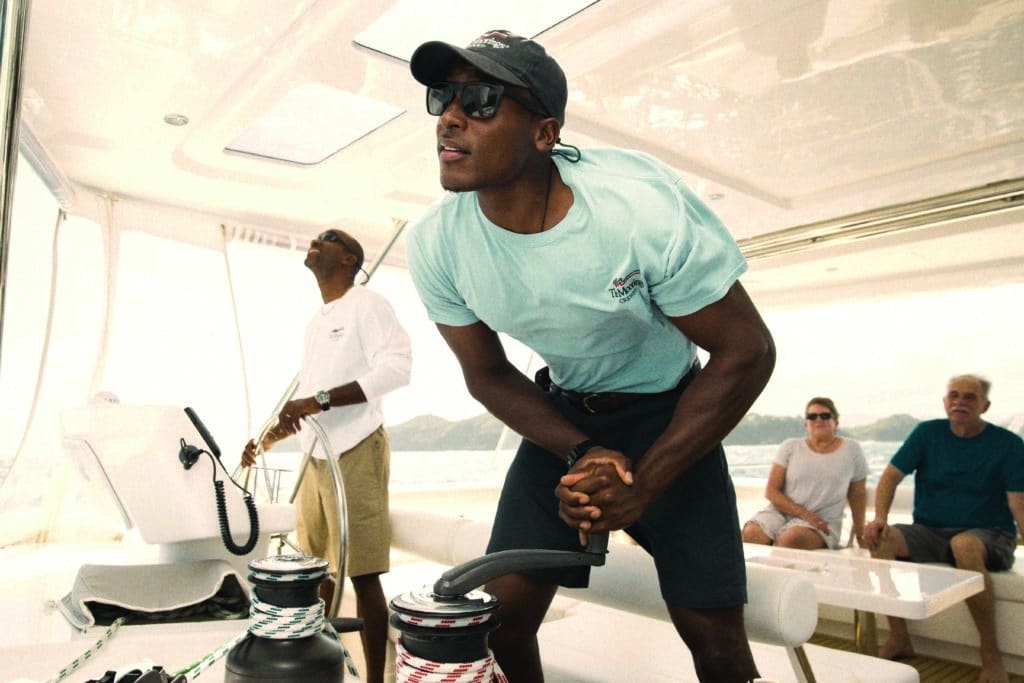
After another fine dinner from Vicky, Cosy treated us to a tasting from his collection of infused rums. Into the bottles of white rum, he’d added ingredients like passion fruit, vanilla, coffee, cinnamon, guava, coconut and island spices (my favorite). He then let them ferment for three weeks or more. I can say two things definitively: They were delicious, and we all slept soundly when our heads hit the pillows.
Another Round, Please We had one more adventure in store before our sail home. On Wednesday morning, Double D motored a short way south to anchor off the beach at Le Carbet, a small community of bars, restaurants and shops. Cosy ferried us to a pier at the north end of the beach, where an old couple stood fishing. In no time, they filled their bucket with small, silvery fish.
The six of us left the dock and walked a mile or so on the main street, following it inland until we found a sign for the Distillerie Neisson. A dirt road led us past groves of trees to a hillside sugar plantation and the distillery, which has been in operation since 1931. Unlike Habitation Clément, this was a strictly commercial concern. Red buildings were arranged around a courtyard and filled with vats, bottling machines and warehouse space. Production takes place only a few months out of the year, and the machinery was idle when we arrived. Even so, at midmorning, the gift shop was filled with people waiting to sample the wares.
When it was our turn, a lively chap and third-generation member of the family spoke broken English and used a poster on the wall to explain the rum-making process, and then stepped briskly behind a counter teeming with bottles and asked if we’d care to try some.
We did.
“You could run your car on this, mate,” noted Nick after sampling one of the more high-octane concoctions. Almost without us noticing, the rum worked its magic, as Tom, who walked into a sign on his way out, could attest.
Fortified for the long 40-mile day ahead of us, we trudged back to Double D, where, after a swim, we got quickly underway. The rhumb line to Rodney Bay took us farther and farther offshore and out of the lee of the island. Soon, we were surrounded by whitecaps, but Cosy, like Double D, took the conditions in stride. They’d seen them before. For the rest of us, it was a heck of a ride, and one I won’t soon forget.
We approached St. Lucia toward sunset — always a lovely time to be at sea — and stars filled the sky by the time the hook was finally set. There was a collective sigh as we sipped cocktails and sat down to one last meal from Vicky, glad to have the crossing over with, even if none of us had lifted a finger to make it happen. As I said at the beginning, welcome to the pleasures of a crewed charter.
Like most sailors, I’ve always found the rewards of a sailing vacation to be in the sailing itself, so spending every day aboard Double D in guest mode took some getting used to. But would I put to sea again with captain and crew? Hell, yes.
Mark Pillsbury is editor of Cruising World.

